On Field Infrared Thermography Sensing for PV System Efficiency Assessment: Results and Comparison with Electrical Models
Abstract
1. Introduction
2. Basics on PV Faults Diagnostics
2.1. Thermal Approach
2.2. Electrical Approach
3. Experimental Setup
3.1. Thermographic Setup
- view all the panels simultaneously; and
- avoid the possibility for the IR camera to influence the acquisition.
3.2. Electrical Setup
4. Results
4.1. Thermograpfic Inspection Results
4.2. Model and Electrical Results
5. Conclusions
Author Contributions
Funding
Acknowledgments
Conflicts of Interest
Abbreviations
| Nomenclature | |
| PV | Photovoltaic |
| I | Current (A) |
| V | Voltage (V) |
| R | Resistance (Ω) |
| P | Power (W) |
| a | Diode Ideality factor (-) |
| STC | Standard test conditions |
| MPP | Maximum power point |
| k | Boltzmann’s constant (−1.380653 × 10–23 J/K) |
| T | Junction’s temperature (K) |
| N | Number of cell |
| q | Electron’s charge (−1.60217646 × 10–19 C) |
| FF | Fill factor (-) |
| PID | Potential induced degradation |
| G | Solar irradiance (W/m2) |
| AY | Actual year |
| IY | Installation year |
| A | Total area of PV panel (m2) |
| IR | Infrared |
| r | Power reduction rate |
| η | Panel efficiency |
| Δη | Panel efficiency drop |
| K | Temperature coefficient |
| Subscripts | |
| oc | Open circuit |
| sc | Short circuit |
| 0 | Diode saturation |
| p | Shunt |
| s | Series |
| d | Diode |
| v | Voltage |
| a | Aged |
| max | Maximum power point |
References
- World Energy Outlook 2016. Available online: https://webstore.iea.org/world-energy-outlook-2016 (accessed on 15 September 2019).
- Cucchiella, F.; D’Adamo, I.; Gastaldi, M. Economic Analysis of a Photovoltaic System: A Resource for Residential Households. Energies 2017, 10, 814. [Google Scholar] [CrossRef]
- Martins, F. PV sector in the European Union countries—Clusters and efficiency. Renew. Sustain. Energy Rev. 2017, 74, 173–177. [Google Scholar] [CrossRef]
- Eder, G.; Voronko, Y.; Hirschl, C.; Ebner, R.; Újvári, G.; Mühleisen, W. Non-Destructive Failure Detection and Visualization of Artificially and Naturally Aged PV Modules. Energies 2018, 11, 1053. [Google Scholar] [CrossRef]
- Lillo-Bravo, I.; González-Martínez, P.; Larrañeta, M.; Guasumba-Codena, J. Impact of Energy Losses Due to Failures on Photovoltaic Plant Energy Balance. Energies 2018, 11, 363. [Google Scholar] [CrossRef]
- Chin, V.; Salam, Z.; Ishaque, K. Cell modelling and model parameters estimation techniques for photovoltaic simulator application: A review. Appl. Energy 2015, 154, 500–519. [Google Scholar] [CrossRef]
- Orsetti, C.; Muttillo, M.; Parente, F.; Pantoli, L.; Stornelli, V.; Ferri, G. Reliable and Inexpensive Solar Irradiance Measurement System Design. Proced. Eng. 2016, 168, 1767–1770. [Google Scholar] [CrossRef]
- Fusacchia, P.; Muttillo, M.; Leoni, A.; Pantoli, L.; Parente, F.; Stornelli, V.; Ferri, G. A Low Cost Fully Integrable in a Standard CMOS Technology Portable System for the Assessment of Wind Conditions. Proced. Eng. 2016, 168, 1024–1027. [Google Scholar] [CrossRef]
- de Rubeis, T.; Nardi, I.; Muttillo, M. Development of a low-cost temperature data monitoring. An upgrade for hot box apparatus. J. Phys. Conf. Ser. 2017, 923, 012039. [Google Scholar] [CrossRef]
- Pantoli, L.; Paolucci, R.; Muttillo, M.; Fusacchia, P.; Leoni, A. A Multisensorial Thermal Anemometer System. Lect. Notes Electr. Eng. 2017, 330–337. [Google Scholar] [CrossRef]
- Pantoli, L.; Muttillo, M.; Stornelli, V.; Ferri, G.; Gabriele, T. A Low Cost Flexible Power Line Communication System. Lect. Notes Electr. Eng. 2017, 413–420. [Google Scholar] [CrossRef]
- Ferri, G.; Parente, F.; Stornelli, V.; Barile, G.; Pantoli, L. Automatic Bridge-based Interface for Differential Capacitive Full Sensing. Proced. Eng. 2016, 168, 1585–1588. [Google Scholar] [CrossRef]
- Barile, G.; Ferri, G.; Parente, F.; Stornelli, V.; Depari, A.; Flammini, A.; Sisinni, E. A standard CMOS bridge-based analog interface for differential capacitive sensors. In Proceedings of the 2017 13th Conference on Ph.D. Research in Microelectronics and Electronics (PRIME), Giardini Naxos, Italy, 12–15 June 2017. [Google Scholar]
- Vergusa, S.; Carpentieri, M. Statistics to Detect Low-Intensity Anomalies in PV Systems. Energies 2017, 11, 30. [Google Scholar]
- Chine, W.; Mellit, A.; Lughi, V.; Malek, A.; Sulligoi, G.; Massi Pavan, A. A novel fault diagnosis technique for photovoltaic systems based on artificial neural networks. Renew. Energy 2016, 90, 501–512. [Google Scholar] [CrossRef]
- Tsanakas, J.; Ha, L.; Buerhop, C. Faults and infrared thermographic diagnosis in operating c-Si photovoltaic modules: A review of research and future challenges. Renew. Sustain. Energy Rev. 2016, 62, 695–709. [Google Scholar] [CrossRef]
- Nardi, I.; Ambrosini, D.; Rubeis, T.; Paoletti, D.; Muttillo, M.; Sfarra, S. Energetic performance analysis of a commercial water-based photovoltaic thermal system (PV/T) under summer conditions. J. Phys. Conf. Ser. 2017, 923, 012040. [Google Scholar] [CrossRef]
- Nardi, I.; de Rubeis, T.; Taddei, M.; Ambrosini, D.; Sfarra, S. The energy efficiency challenge for a historical building undergone to seismic and energy refurbishment. Energy Proced. 2017, 133, 231–242. [Google Scholar] [CrossRef]
- Moretón, R.; Pigueiras, E.; Leloux, J.; Carrillo, J. Dealing in practice with hot-spots. In Proceedings of the 29th European Photovoltaic Solar Energy Conference and Exhibition, Amsterdam, The Netherlands, 22–26 September 2014. [Google Scholar]
- Hu, Y.; Cao, W.; Ma, J.; Finney, S.; Li, D. Identifying PV Module Mismatch Faults by a Thermography-Based Temperature Distribution Analysis. IEEE Trans. Device Mater. Reliab. 2014, 14, 951–960. [Google Scholar] [CrossRef]
- Buerhop, C.; Schlegel, D.; Niess, M.; Vodermayer, C.; Weißmann, R.; Brabec, C. Reliability of IR-imaging of PV-plants under operating conditions. Solar Energy Mater. Solar Cells 2012, 107, 154–164. [Google Scholar] [CrossRef]
- Gallardo-Saavedra, S.; Hernández-Callejo, L.; Duque-Perez, O. Technological review of the instrumentation used in aerial thermographic inspection of photovoltaic plants. Renew. Sustain. Energy Rev. 2018, 93, 566–579. [Google Scholar] [CrossRef]
- Zefri, Y.; ElKettani, A.; Sebari, I.; Lamallam, S. Thermal Infrared and Visual Inspection of Photovoltaic Installations by UAV Photogrammetry—Application Case: Morocco. Drones 2018, 2, 41. [Google Scholar] [CrossRef]
- Nardi, I.; Muttillo, M.; de Rubeis, T.; Sarcina, M.; Sfarra, S.; Ambrosini, D.; Paoletti, D. Coupling infrared thermography and MATLAB models for photovoltaic (PV) system efficiency characterization: Results from on field tests. In Proceedings of the 2018 XXXVI UIT Heat Transfer Conference, Catania, Italy, 25–27 June 2018. [Google Scholar]
- Toledo, C.; Serrano, L.; Abad, J.; Lampitelli, A.; Urbina, A. Measurement of Thermal and Electrical Parameters in Photovoltaic Systems for Predictive and Cross-Correlated Monitorization. Energies 2019, 12, 668. [Google Scholar] [CrossRef]
- Teubner, J.; Kruse, I.; Scheuerpflug, H.; Buerhop-Lutz, C.; Hauch, J.; Camus, C.; Brabec, C. Comparison of Drone-based IR-imaging with Module Resolved Monitoring Power Data. Energy Proced. 2017, 124, 560–566. [Google Scholar] [CrossRef]
- Jaffery, Z.A.; Haque, A. Temperature measurement of solar module in outdoor operating conditions using thermal imaging. Infrared Phys. Technol. 2018, 92, 134–138. [Google Scholar] [CrossRef]
- Takyi, G. Correlation of Infrared Thermal Imaging Results with Visual Inspection and Current-Voltage Data of PV Modules Installed in Kumasi, a Hot, Humid Region of Sub-Saharan Africa. Technologies 2017, 5, 67. [Google Scholar] [CrossRef]
- Schirripa Spagnolo, G.; Del Vecchio, P.; Makary, G.; Papalillo, D.; Martocchia, A. A review of IR thermography applied to PV systems. In Proceedings of the 2012 11th International Conference on Environment and Electrical Engineering, Venice, Italy, 18–25 May 2012. [Google Scholar]
- Marking and documentation requirements for Photovoltaic Modules. Available online: https://infostore.saiglobal.com/preview/258932822267.pdf?sku=860328_SAIG_NSAI_NSAI_2046784 (accessed on 15 September 2019).
- Liu, X.; Wang, Y. Reconfiguration Method to Extract More Power from Partially Shaded Photovoltaic Arrays with Series-Parallel Topology. Energies 2019, 12, 1439. [Google Scholar] [CrossRef]
- Carrero, C.; Amador, J.; Arnaltes, S. A single procedure for helping PV designers to select silicon PV modules and evaluate the loss resistances. Renew. Energy 2007, 32, 2579–2589. [Google Scholar] [CrossRef]
- Implement PV array modules—Simulink—Math Works Italia. Available online: https://it.mathworks.com/help/physmod/sps/powersys/ref/pvarray.html (accessed on 15 September 2019).
- Gulkowski, S.; Zdyb, A.; Dragan, P. Experimental Efficiency Analysis of a Photovoltaic System with Different Module Technologies under Temperate Climate Conditions. Appl. Sci. 2019, 9, 141. [Google Scholar] [CrossRef]
- Siddique, H.A.B.; Xu, P.; De Doncker, R.W. Parameter extraction algorithm for one-diode model of PV panels based on datasheet values. In Proceedings of the International Conference on Clean Electrical Power (ICCEP), Alghero, Italy, 11–13 June 2013; pp. 7–13. [Google Scholar]
- Photovoltaic Degradation Rates—An Analytical Review. Available online: https://www.nrel.gov/docs/fy12osti/51664.pdf (accessed on 15 September 2019).
- Silvestre, S.; Tahri, A.; Tahri, F.; Benlebna, S.; Chouder, A. Evaluation of the performance and degradation of crystalline silicon-based photovoltaic modules in the Saharan environment. Energy 2018, 152, 57–63. [Google Scholar] [CrossRef]
- Shravanth Vasisht, M.; Srinivasan, J.; Ramasesha, S. Performance of solar photovoltaic installations: Effect of seasonal variations. Solar Energy 2016, 131, 39–46. [Google Scholar] [CrossRef]
- Fouad, M.; Shihata, L.; Morgan, E. An integrated review of factors influencing the perfomance of photovoltaic panels. Renew. Sustain. Energy Rev. 2017, 80, 1499–1511. [Google Scholar] [CrossRef]
- Madeti, S.; Singh, S. Monitoring system for photovoltaic plants: A review. Renew. Sustain. Energy Rev. 2017, 67, 1180–1207. [Google Scholar] [CrossRef]
- de Simón-Martín, M.; Diez-Suárez, A.; Álvarez-de Prado, L.; González-Martínez, A.; de la Puente-Gil, Á.; Blanes-Peiró, J. Development of a GIS Tool for High Precision PV Degradation Monitoring and Supervision: Feasibility Analysis in Large and Small PV Plants. Sustainability 2017, 9, 965. [Google Scholar] [CrossRef]
- Phinikarides, A.; Kindyni, N.; Makrides, G.; Georghiou, G. Review of photovoltaic degradation rate methodologies. Renew. Sustain. Energy Rev. 2014, 40, 143–152. [Google Scholar] [CrossRef]
- Djordjevic, S.; Parlevliet, D.; Jennings, P. Detectable faults on recently installed solar modules in Western Australia. Renew. Energy 2014, 67, 215–221. [Google Scholar] [CrossRef]
- Madeti, S.; Singh, S. A comprehensive study on different types of faults and detection techniques for solar photovoltaic system. Solar Energy 2017, 158, 161–185. [Google Scholar] [CrossRef]
- Maghami, M.; Hizam, H.; Gomes, C.; Radzi, M.; Rezadad, M.; Hajighorbani, S. Power loss due to soiling on solar panel: A review. Renew. Sustain. Energy Rev. 2016, 59, 1307–1316. [Google Scholar] [CrossRef]
- Gosumbonggot, J.; Fujita, G. Global Maximum Power Point Tracking under Shading Condition and Hotspot Detection Algorithms for Photovoltaic Systems. Energies 2019, 12, 882. [Google Scholar] [CrossRef]
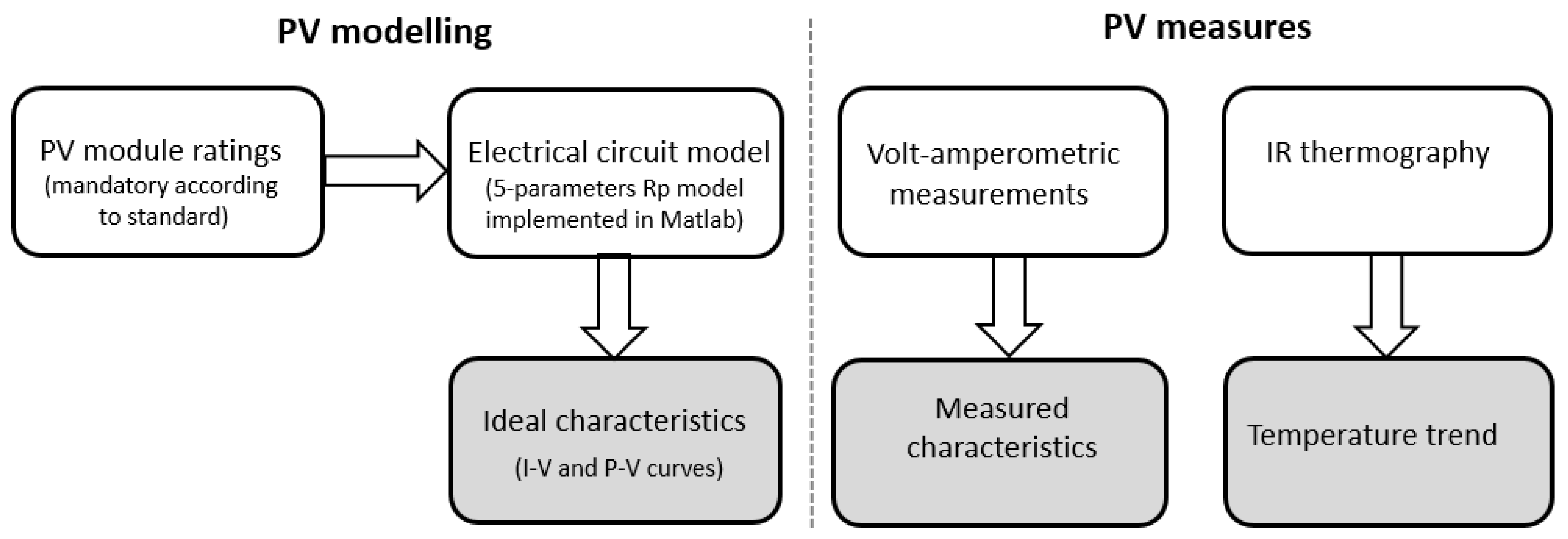




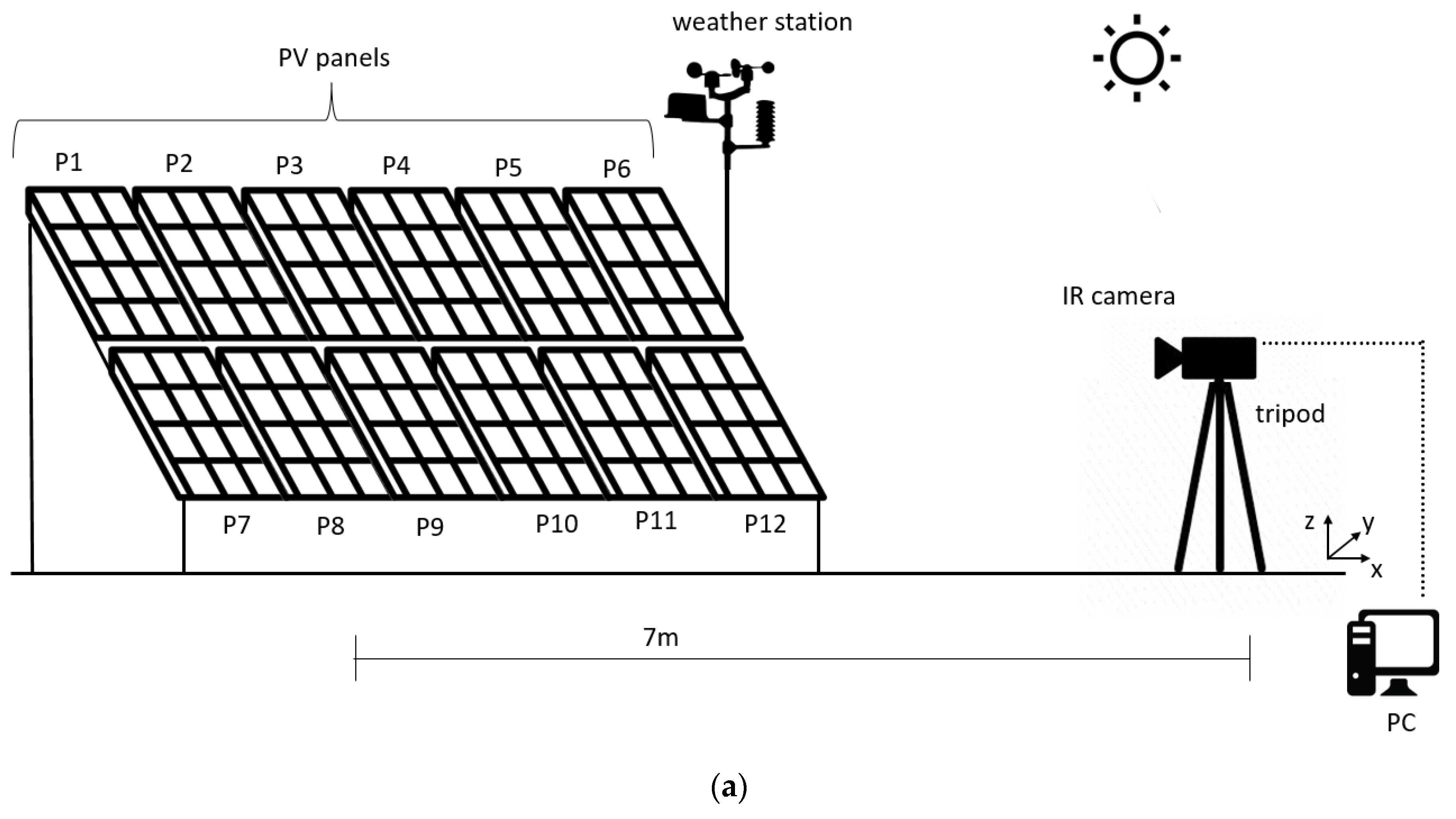
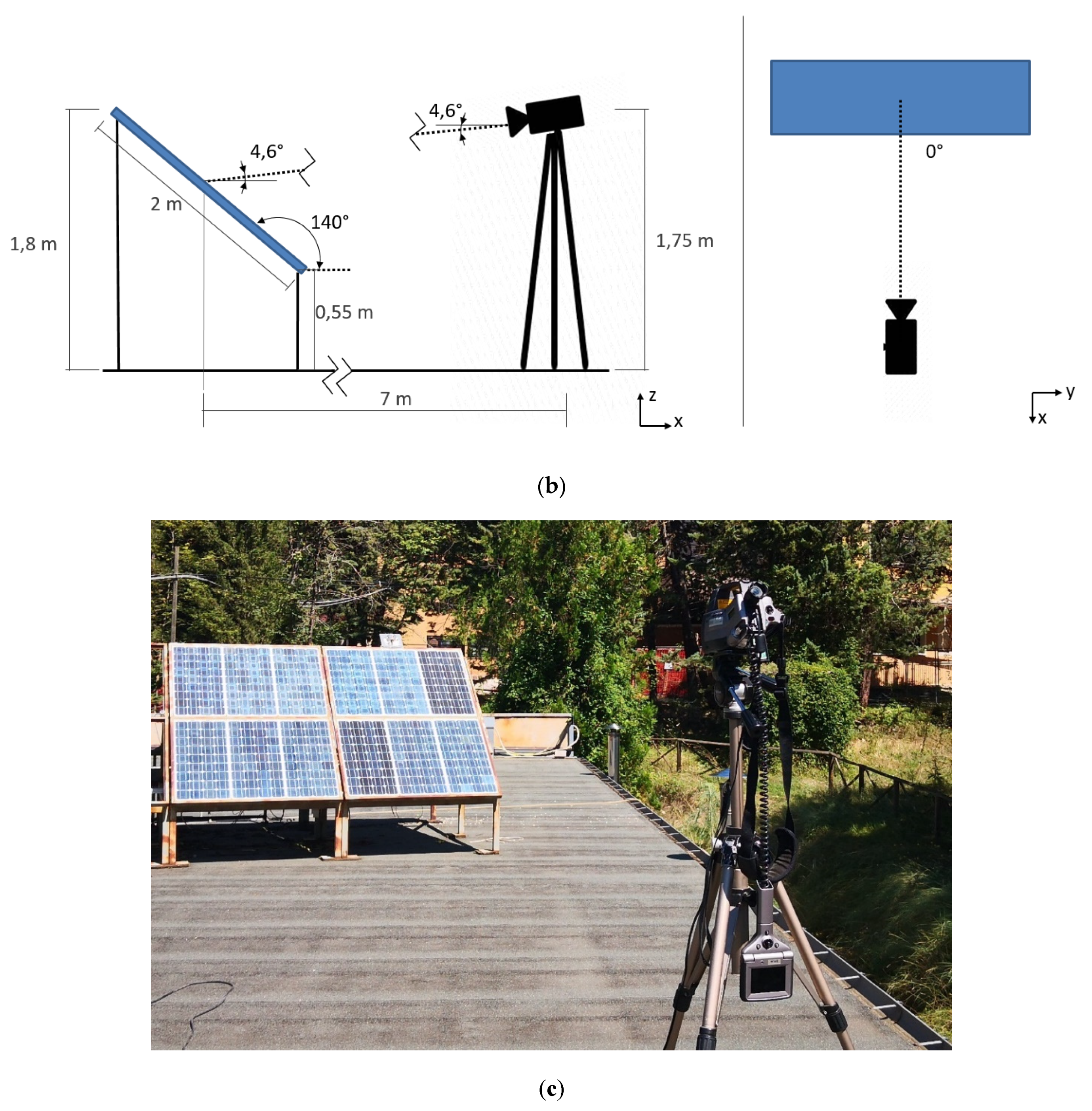

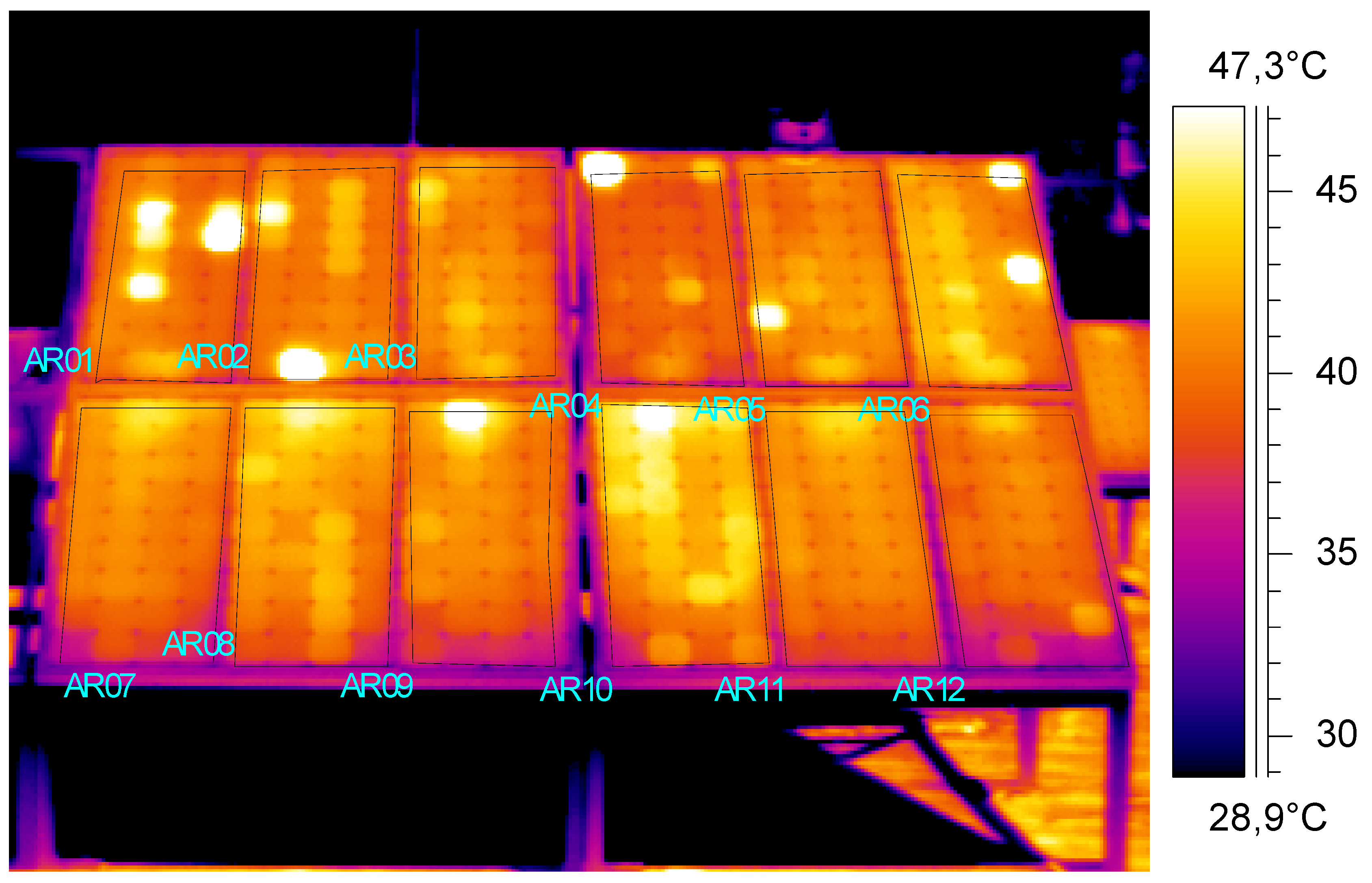
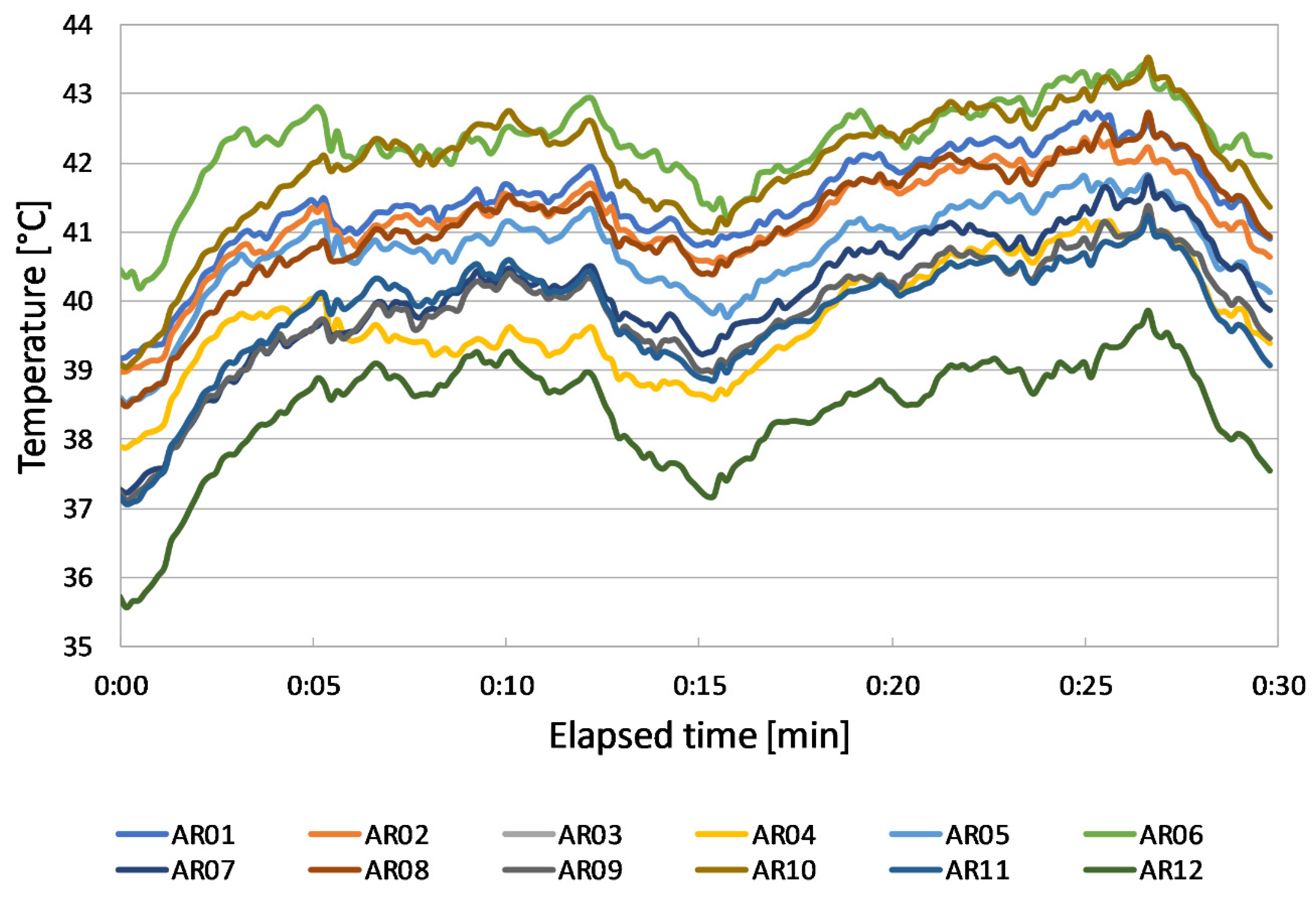


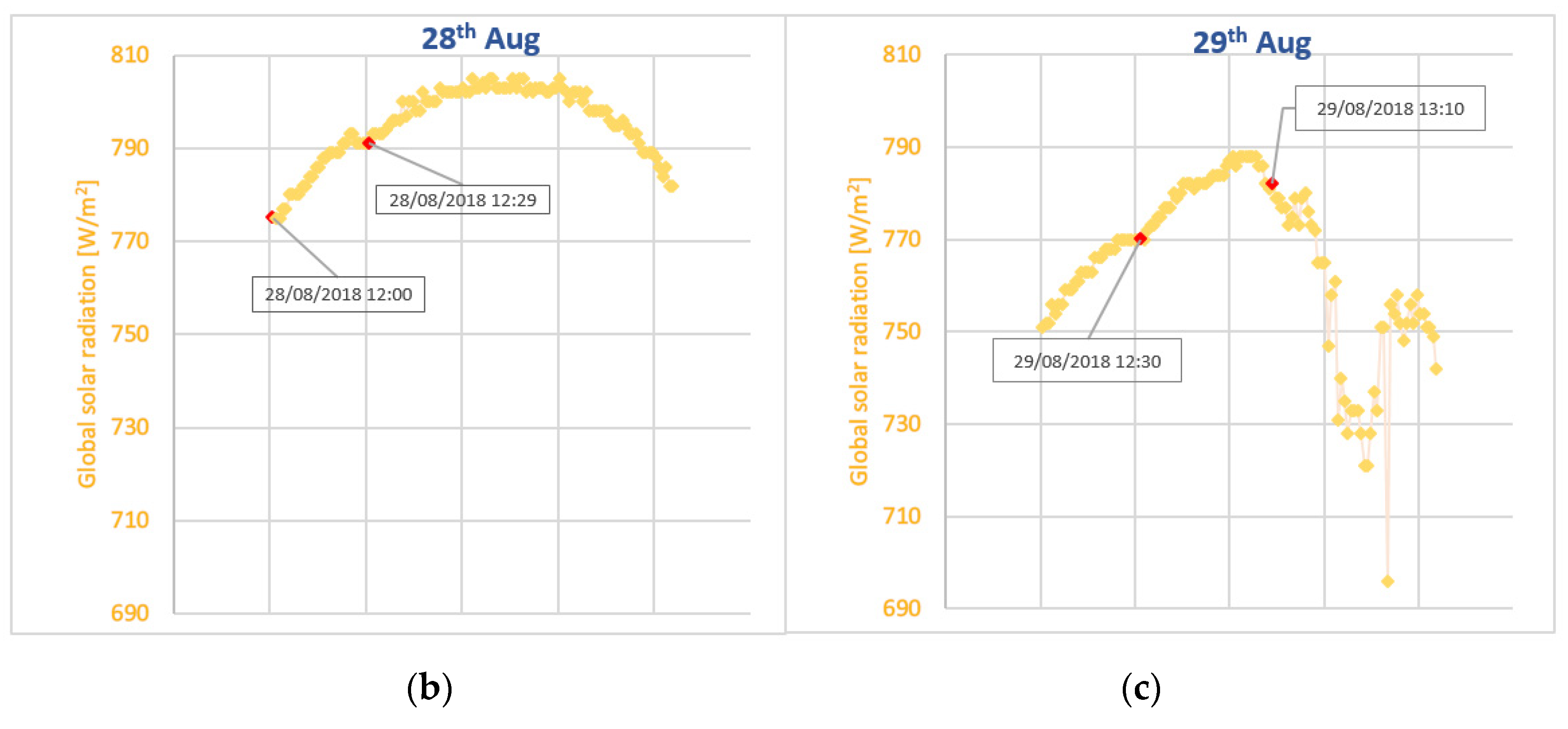

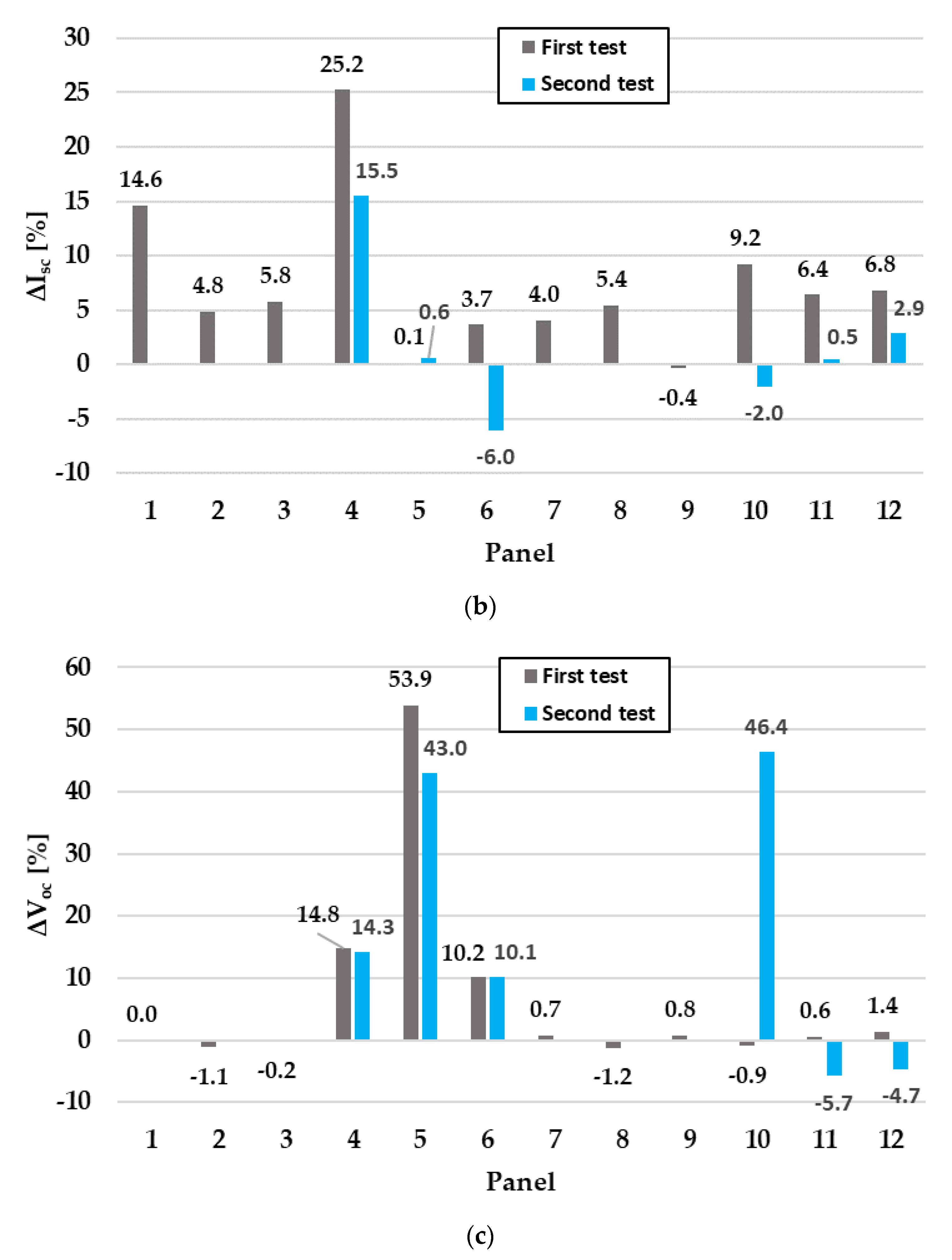
| Panel | ||||||||||||
|---|---|---|---|---|---|---|---|---|---|---|---|---|
| 1 | 2 | 3 | 4 | 5 | 6 | 7 | 8 | 9 | 10 | 11 | 12 | |
| Isc (A) | 2.15 | 2.14 | 2.09 | 2.08 | 2.18 | 2.31 | 2.09 | 2.08 | 1.95 | 2.08 | 2.13 | 2.09 |
| Imax (A) | 1.81 | 1.82 | 1.75 | 1.51 | 1.74 | 1.72 | 1.50 | 1.66 | 1.39 | 1.82 | 1.58 | 1.64 |
| Panel | Irradiance (W/m2) | Temperature (°C) | Vmax (V) | Imax (A) | Pmax (W) | Isc (A) | Voc (V) | FF (-) | η (%) | ||||||||||||||||||
|---|---|---|---|---|---|---|---|---|---|---|---|---|---|---|---|---|---|---|---|---|---|---|---|---|---|---|---|
| S | M | R | S | M | R | S | M | R | S | M | R | S | M | R | S | M | R | S | M | R | S | M | R | S | M | R | |
| 1 | 1042 | 1042 | 1000 | 40.8 | 40.8 | 25.0 | 9.8 | 10.5 | 11.7 | 1.6 | 1.7 | 2.5 | 16.2 | 17.6 | 29.2 | 2.4 | 2.1 | 2.9 | 17.6 | 17.6 | 20.5 | 0.4 | 0.5 | 0.5 | 4.3 | 4.7 | 8.1 |
| 2 | 1032 | 1032 | 1000 | 40.6 | 40.6 | 25.0 | 12.1 | 12.3 | 14.8 | 1.8 | 1.8 | 2.5 | 22.3 | 21.9 | 36.9 | 2.2 | 2.1 | 2.9 | 18.0 | 18.2 | 21.0 | 0.6 | 0.6 | 0.6 | 6.0 | 5.9 | 10.3 |
| 3 | 1046 | 1046 | 1000 | 40.2 | 40.2 | 25.0 | 13.3 | 13.4 | 15.9 | 1.8 | 1.6 | 2.4 | 24.2 | 21.9 | 38.1 | 2.2 | 2.1 | 2.9 | 17.8 | 17.9 | 20.6 | 0.6 | 0.6 | 0.6 | 6.4 | 5.8 | 10.6 |
| 4.1 | 1048 | 1048 | 1000 | 39.3 | 39.3 | 25.0 | 17.9 | 16.6 | 19.1 | 1.8 | 1.0 | 2.1 | 32.3 | 16.6 | 39.5 | 2.2 | 1.6 | 2.9 | 22.1 | 18.8 | 21.7 | 0.7 | 0.5 | 0.7 | 9.5 | 4.4 | 12.4 |
| 4.2 | 949 | 949 | 1000 | 46.5 | 46.5 | 25.0 | 17.4 | 13.6 | 19.1 | 1.6 | 1.4 | 2.1 | 28.5 | 19.3 | 39.5 | 2.0 | 1.7 | 2.9 | 21.5 | 18.4 | 21.7 | 0.7 | 0.6 | 0.7 | 7.6 | 5.6 | 12.4 |
| 5.1 | 1061 | 1061 | 1000 | 40.0 | 40.0 | 25.0 | 14.4 | 6.4 | 17.1 | 1.8 | 1.8 | 2.3 | 25.9 | 11.4 | 39.1 | 2.2 | 2.2 | 2.9 | 18.5 | 8.6 | 21.4 | 0.6 | 0.6 | 0.6 | 6.8 | 3.0 | 10.9 |
| 5.2 | 955 | 955 | 1000 | 47.1 | 47.1 | 25.0 | 13.0 | 7.1 | 17.1 | 1.6 | 1.7 | 2.3 | 21.0 | 11.9 | 39.1 | 2.0 | 2.0 | 2.9 | 17.0 | 9.7 | 21.4 | 0.6 | 0.6 | 0.6 | 6.1 | 3.5 | 10.9 |
| 6.1 | 1057 | 1057 | 1000 | 41.7 | 41.7 | 25.0 | 13.0 | 14.4 | 17.3 | 2.2 | 1.6 | 2.3 | 28.4 | 22.4 | 39.1 | 2.5 | 2.4 | 3.0 | 20.3 | 18.2 | 21.0 | 0.6 | 0.5 | 0.6 | 7.5 | 5.9 | 10.3 |
| 6.2 | 970 | 970 | 1000 | 49.1 | 49.1 | 25.0 | 15.3 | 13.4 | 17.3 | 1.9 | 1.7 | 2.3 | 28.5 | 22.2 | 39.1 | 2.3 | 2.4 | 3.0 | 19.6 | 17.6 | 21.0 | 0.6 | 0.5 | 0.6 | 8.2 | 6.4 | 10.3 |
| 7 | 1036 | 1036 | 1000 | 39.4 | 39.4 | 25.0 | 14.4 | 14.4 | 17.0 | 1.6 | 1.5 | 2.1 | 23.1 | 22.2 | 35.1 | 2.2 | 2.1 | 2.9 | 19.0 | 18.8 | 21.7 | 0.6 | 0.6 | 0.5 | 6.2 | 6.0 | 9.7 |
| 8 | 1023 | 1023 | 1000 | 40.7 | 40.7 | 25.0 | 13.6 | 14.1 | 16.4 | 1.7 | 1.6 | 2.3 | 23.2 | 22.0 | 37.1 | 2.2 | 2.0 | 2.9 | 18.3 | 18.6 | 21.3 | 0.6 | 0.6 | 0.6 | 6.3 | 6.0 | 10.3 |
| 9 | 1036 | 1036 | 1000 | 39.4 | 39.4 | 25.0 | 14.0 | 13.4 | 16.3 | 1.5 | 1.4 | 1.9 | 20.8 | 19.2 | 31.0 | 2.1 | 2.1 | 2.7 | 18.8 | 18.6 | 21.3 | 0.5 | 0.5 | 0.5 | 5.6 | 5.2 | 8.6 |
| 10.1 | 1041 | 1041 | 1000 | 41.1 | 41.1 | 25.0 | 13.3 | 12.9 | 16.2 | 1.8 | 1.6 | 2.4 | 24.1 | 20.2 | 38.8 | 2.2 | 2.0 | 2.9 | 18.1 | 18.2 | 21.2 | 0.6 | 0.6 | 0.6 | 6.4 | 5.4 | 10.8 |
| 10.2 | 958 | 958 | 1000 | 47.4 | 47.4 | 25.0 | 12.2 | 6.5 | 16.2 | 1.7 | 1.5 | 2.4 | 20.2 | 10.0 | 38.8 | 2.0 | 2.1 | 2.9 | 16.8 | 9.0 | 21.2 | 0.6 | 0.5 | 0.6 | 5.8 | 2.9 | 10.8 |
| 11.1 | 1027 | 1027 | 1000 | 39.0 | 39.0 | 25.0 | 14.7 | 14.4 | 17.2 | 1.7 | 1.6 | 2.2 | 24.4 | 22.7 | 37.0 | 2.2 | 2.1 | 2.9 | 18.9 | 18.8 | 21.6 | 0.6 | 0.6 | 0.6 | 6.6 | 6.1 | 10.3 |
| 11.2 | 944 | 944 | 1000 | 45.9 | 45.9 | 25.0 | 13.3 | 13.5 | 17.2 | 1.5 | 1.5 | 2.2 | 20.5 | 20.3 | 37.0 | 2.0 | 2.0 | 2.9 | 17.4 | 18.4 | 21.6 | 0.6 | 0.5 | 0.6 | 6.0 | 6.0 | 10.3 |
| 12.1 | 1016 | 1016 | 1000 | 37.4 | 37.4 | 25.0 | 14.5 | 13.1 | 16.7 | 1.7 | 1.5 | 2.3 | 24.4 | 20.0 | 37.7 | 2.2 | 2.0 | 2.9 | 19.2 | 18.9 | 21.7 | 0.6 | 0.5 | 0.6 | 6.7 | 5.5 | 10.5 |
| 12.2 | 955 | 955 | 1000 | 44.7 | 44.7 | 25.0 | 13.1 | 13.9 | 16.7 | 1.6 | 1.5 | 2.3 | 20.8 | 21.4 | 37.7 | 2.0 | 2.0 | 2.9 | 17.7 | 18.5 | 21.7 | 0.6 | 0.6 | 0.6 | 6.1 | 6.2 | 10.5 |
| Panel | ΔIsc (A) | ΔVoc (V) | ΔPmax (W) | ΔFF | Δη (%) |
|---|---|---|---|---|---|
| 1 | 0.350 | 0.005 | −1.397 | −0.104 | −0.369 |
| 2 | 0.108 | −0.198 | 0.350 | −0.013 | 0.098 |
| 3 | 0.128 | −0.043 | 2.229 | 0.024 | 0.597 |
| 4 | 0.553 | 3.273 | 15.741 | 0.130 | 5.079 |
| 5 | 0.003 | 9.992 | 14.492 | 0.028 | 3.796 |
| 6 | 0.090 | 2.070 | 6.028 | 0.051 | 1.583 |
| 7 | 0.088 | 0.135 | 0.918 | −0.004 | 0.246 |
| 8 | 0.118 | −0.220 | 1.184 | 0.005 | 0.325 |
| 9 | −0.008 | 0.151 | 1.511 | 0.037 | 0.406 |
| 10 | 0.202 | −0.171 | 3.888 | 0.052 | 1.039 |
| 11 | 0.141 | 0.112 | 1.667 | −0.001 | 0.448 |
| 12 | 0.147 | 0.261 | 4.410 | 0.064 | 1.204 |
| Panel | ΔIsc (A) | ΔVoc (V) | ΔPmax (W) | ΔFF | Δη (%) |
|---|---|---|---|---|---|
| 4 | 0.308 | 3.059 | 9.261 | 0.046 | 1.921 |
| 5 | 0.011 | 7.302 | 9.174 | 0.003 | 2.671 |
| 6 | −0.137 | 1.985 | 6.352 | 0.119 | 1.821 |
| 10 | −0.040 | 7.786 | 10.139 | 0.054 | 2.939 |
| 11 | 0.009 | −0.999 | 0.228 | 0.035 | 0.065 |
| 12 | 0.059 | −0.826 | −0.538 | −0.005 | −0.159 |
© 2020 by the authors. Licensee MDPI, Basel, Switzerland. This article is an open access article distributed under the terms and conditions of the Creative Commons Attribution (CC BY) license (http://creativecommons.org/licenses/by/4.0/).
Share and Cite
Muttillo, M.; Nardi, I.; Stornelli, V.; de Rubeis, T.; Pasqualoni, G.; Ambrosini, D. On Field Infrared Thermography Sensing for PV System Efficiency Assessment: Results and Comparison with Electrical Models. Sensors 2020, 20, 1055. https://doi.org/10.3390/s20041055
Muttillo M, Nardi I, Stornelli V, de Rubeis T, Pasqualoni G, Ambrosini D. On Field Infrared Thermography Sensing for PV System Efficiency Assessment: Results and Comparison with Electrical Models. Sensors. 2020; 20(4):1055. https://doi.org/10.3390/s20041055
Chicago/Turabian StyleMuttillo, Mirco, Iole Nardi, Vincenzo Stornelli, Tullio de Rubeis, Giovanni Pasqualoni, and Dario Ambrosini. 2020. "On Field Infrared Thermography Sensing for PV System Efficiency Assessment: Results and Comparison with Electrical Models" Sensors 20, no. 4: 1055. https://doi.org/10.3390/s20041055
APA StyleMuttillo, M., Nardi, I., Stornelli, V., de Rubeis, T., Pasqualoni, G., & Ambrosini, D. (2020). On Field Infrared Thermography Sensing for PV System Efficiency Assessment: Results and Comparison with Electrical Models. Sensors, 20(4), 1055. https://doi.org/10.3390/s20041055









